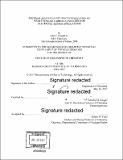| dc.contributor.advisor | Timothy M. Swager. | en_US |
| dc.contributor.author | Fennell, John F., Jr. (John Francis) | en_US |
| dc.contributor.other | Massachusetts Institute of Technology. Department of Chemistry. | en_US |
| dc.date.accessioned | 2017-12-05T19:12:39Z | |
| dc.date.available | 2017-12-05T19:12:39Z | |
| dc.date.copyright | 2017 | en_US |
| dc.date.issued | 2017 | en_US |
| dc.identifier.uri | http://hdl.handle.net/1721.1/112434 | |
| dc.description | Thesis: Ph. D., Massachusetts Institute of Technology, Department of Chemistry, 2017. | en_US |
| dc.description | Cataloged from PDF version of thesis. Vita. | en_US |
| dc.description | Includes bibliographical references. | en_US |
| dc.description.abstract | In this thesis, chemiresistive devices for the detection of volatile organic compounds to include chemical warfare agents are developed. Active sensing materials were produced by crafting composites of synthetic polymers and single walled carbon nanotubes. Sensitivity to and selectivity for target analytes were augmented by the introduction of molecular recognition elements into polymer side chains or by the addition of additives into a polymer/single walled nanotube composite. Additionally, methods to create n-type single walled carbon nanotubes through covalent side wall functionalization were explored. Chapter 1: Chemiresistive sensors are becoming increasingly important as they offer an inexpensive option to conventional analytical instrumentation, they can be readily integrated into electronic devices, and they have low power requirements. Nanowires (NWs) are a major theme in chemosensor development. High surface area, inter-wire junctions, and restricted conduction pathways give intrinsically high sensitivity and new mechanisms to transduce binding or action of analytes. This chapter details the status of NW chemosensors with selected examples from the literature. We begin by proposing a framework for understanding electrical transport and transduction mechanisms in NW sensors. Next, we offer the reader a review of device performance parameters. Then, we consider the different NW types followed by a summary of NW assembly and different device platform architectures. Subsequently, we discuss NW functionalization strategies. Finally, we propose a roadmap for future developments in NW sensing that addresses selectivity, sensor drift, sensitivity, response analysis, and emerging applications. The NW field is still in its infancy, and continuing advances present abundant opportunities. Chapter 2: Chemical warfare agents (CWA) continue to present a threat to civilian populations and military personnel in operational areas all over the world. Reliable measurements of CWAs are critical to contamination detection, avoidance, and remediation. The current deployed systems in United States and foreign militaries, as well as those in the private sector offer accurate detection of CWAs, but are still limited by size, portability and fabrication cost. Herein, we report a chemiresistive CWA sensor using single-walled carbon nanotubes (SWCNTs) wrapped with poly(3,4-ethylenedioxythiophene) (PEDOT) derivatives. We demonstrate that a pendant hexafluoroisopropanol group on the polymer that enhances sensitivity to a nerve agent mimic, dimethyl methylphosphonate, in both nitrogen and air environments to concentrations as low as 5 ppm and 11 ppm, respectively. Additionally, these PEDOT/SWCNT derivative sensor systems experience negligible device performance over the course of two weeks under ambient conditions. Chapter 3: The detection of alkylating agents using carbon nanotube chemiresistive devices has confounded researchers in the sensor field for quite some time. In this work, we address this quandary by fabricating a chemiresistive device consisting of poly(4-vinylpyridine)/single walled carbon nanotube/lithium bromide composites that is able to detect gaseous ethylene oxide (EtO) and a mustard agent simulant, 2-chloroethyl ethylsulfide (CEES). Our devices were sensitive to EtO and CEES down to 1048 ppm and 33 ppm, respectively. We calculated theoretical detection limits of 212 ppm for EtO and 10 ppm for CEES. These results should encourage researchers in the field to tackle analytes once thought to be undetectable via carbon nanotube chemiresistive devices, as they offer a low cost and low power alternative to current options. Chapter 4: The covalent functionalization and characterization of single walled carbon nanotubes (SWCNTs) by dihalocarbenes and the trifluoromethylating Togni's reagent is explored in this chapter. Covalent functionalization reactions were performed to increase the SWCNT solubility, imparting n-type semiconducting behavior while maintaining the native conductivity of the conjugated sp² network. Previous computational studies predicted the conservation of the electrical conductivity of SWCNTS after carbene additions, but experimental work to verify the electrical properties has not been performed. In the studies presented herein, we utilized five different covalent functionalization methods to modify SWCNTs and utilized X-ray photoelectron spectroscopy (XPS) in tandem with Resonance Raman spectroscopy to characterize our products. Though electrical characterization was not performed, we improved upon literature methods concerning the dichlorocarbene addition of -CCl₂ groups to pristine SWCNTs. | en_US |
| dc.description.statementofresponsibility | by John F. Fennell Jr. | en_US |
| dc.format.extent | 199 pages | en_US |
| dc.language.iso | eng | en_US |
| dc.publisher | Massachusetts Institute of Technology | en_US |
| dc.rights | MIT theses are protected by copyright. They may be viewed, downloaded, or printed from this source but further reproduction or distribution in any format is prohibited without written permission. | en_US |
| dc.rights.uri | http://dspace.mit.edu/handle/1721.1/7582 | en_US |
| dc.subject | Chemistry. | en_US |
| dc.title | Polymer and covalent functionalization of single walled carbon nanotubes for electronic sensor applications | en_US |
| dc.type | Thesis | en_US |
| dc.description.degree | Ph. D. | en_US |
| dc.contributor.department | Massachusetts Institute of Technology. Department of Chemistry | |
| dc.identifier.oclc | 1008879989 | en_US |
